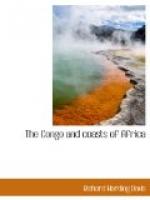But, you never see a hippopotamus chained to a road-roller, or riding a bicycle. He is still the gentleman, the man of elegant leisure, the aristocrat of aristocrats, harming no one, and, in his ancestral river, living the simple life.
And yet, I sought to kill him. At least, one of him, but only one. And, that I did not kill even one, while a bitter disappointment, is still a source of satisfaction.
In the Congo River we saw only two hippos, and both of them were dead. They had been shot from a steamer. If the hippo is killed in the water, it is impossible to recover the body at once. It sinks and does not rise, some say, for an hour, others say for seven hours. As in an hour the current may have carried the body four miles below where it sank, the steamer does not wait, and the destruction of the big beast is simple murder. There should be a law in the Congo to prevent their destruction, and, no doubt, if the State thought it could make a few francs out of protecting the hippo, as it makes many million francs by preserving the elephant, which it does for the ivory, such a law would exist. We soon saw many hippos, but although we could not persuade the only other passenger not to fire at them, there are a few hippos still alive in the Congo. For, the only time the Captain and I were positive he hit anything, was when he fired over our heads and blew off the roof of the bridge.
When first we saw the two dead hippos, one of them was turning and twisting so violently that we thought he was alive. But, as we drew near, we saw the strange convulsions were due to two enormous and ugly crocodiles, who were fiercely pulling at the body. Crocodiles being man-eaters, we had no feelings about shooting them, either in the water or up a tree; and I hope we hit them. In any event, after we fired the body drifted on in peace.
On my return trip, going with the stream, when the boat covers about four times the distance she makes when steaming against it, I saw many hippos. In one day I counted sixty-nine. But on our way up the Congo, until we turned into the Kasai River, we saw none.
So, on the first night we camped in the Kasai I had begun to think I never would see one, and I went ashore both skeptical and discouraged. We had stopped, not at a wood post, but at a place on the river’s bank previously untouched by man, where there was a stretch of beach, and then a higher level with trees and tall grasses. Driven deep in this beach were the footprints of a large elephant. They looked as though some one had amused himself by sinking a bucket in the mud, and then pulling it out. For sixty yards I followed the holes and finally lost them in a confusion of other tracks. The place had been so trampled upon that it was beaten into a basin. It looked as though every animal in the Kasai had met there to hold a dance. There were the deep imprints of the hippos and the round foot of the elephant, with the marks of the big toes showing




